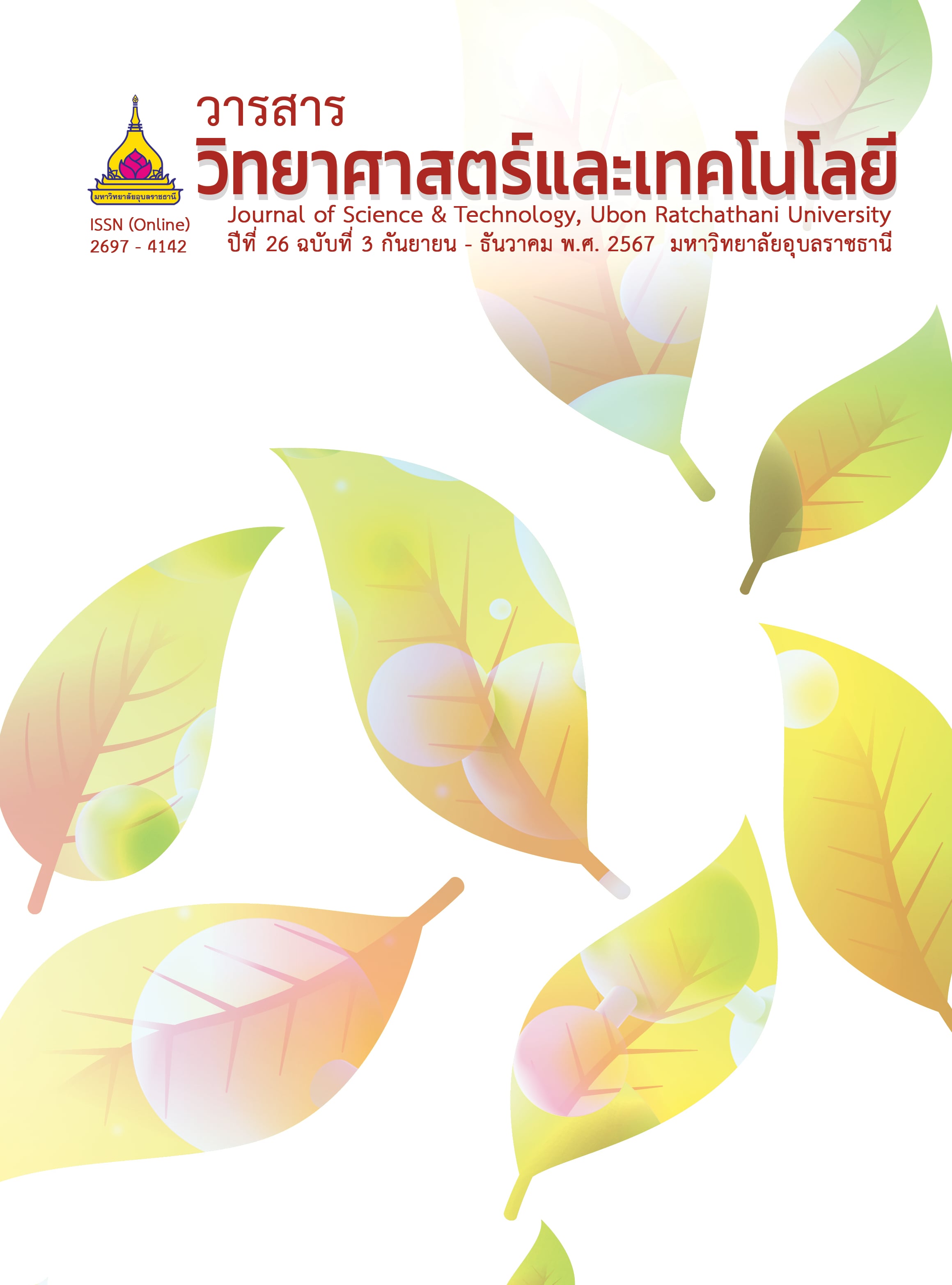ผลของปริมาณความชื้นต่อประสิทธิภาพการสกัดน้ำมันและคุณภาพทางเคมีของน้ำมันจิ้งหรีดทองดำ ที่ได้จากการสกัดด้วยวิธีการบีบอัดแบบสกรู
Main Article Content
บทคัดย่อ
งานวิจัยนี้มีวัตถุประสงค์เพื่อศึกษาผลของปริมาณความชื้นต่อประสิทธิภาพการสกัดน้ำมัน และคุณภาพทางเคมีของน้ำมันจิ้งหรีดทองดำที่ได้จากการสกัดด้วยวิธีการบีบอัดแบบสกรู โดยทำการอบตัวอย่างจิ้งหรีดทองดำในตู้อบลมร้อนแบบถาดที่อุณหภูมิ 50±5 องศาเซลเซียส และสุ่มตัวอย่างที่ระยะเวลาต่างกัน คือ 0, 3, 5, 7 และ 9 ชั่วโมงหลังการอบ เพื่อวิเคราะห์ปริมาณความชื้น และทำการบีบน้ำมันที่อุณหภูมิ 100±5 องศาเซลเซียส ความเร็วรอบของสกรูในการบีบ 48 รอบต่อนาที จากนั้นคำนวณร้อยละของผลผลิตน้ำมันที่สกัดได้ (% oil yield) และร้อยละของน้ำมันที่สกัดได้จากน้ำมันทั้งหมด (% oil recovery) ซึ่งเป็นค่าที่บ่งบอกถึงประสิทธิภาพการสกัดน้ำมัน รวมทั้งวิเคราะห์คุณภาพทางเคมีของน้ำมัน ซึ่งได้แก่ ค่าเพอร์ออกไซด์ และค่ากรด จากผลการทดลองพบว่าระยะเวลาในการอบจิ้งหรีดทองดำมีผลต่อค่าความชื้นของจิ้งหรีดทองดำอย่างมีนัยสำคัญทางสถิติ (p<0.05) โดยจิ้งหรีดทองดำมีความชื้นเริ่มต้น (0 ชั่วโมง) ร้อยละ 62-63 และลดลงเหลือร้อยละ 3-4 หลังจากอบเป็นเวลานาน 9 ชั่วโมง จากการบีบน้ำมันจากจิ้งหรีดทองดำพบว่าความชื้นของตัวอย่างจิ้งหรีดทองดำมีผลต่อ % oil yield และ % oil recovery อย่างมีนัยสำคัญทางสถิติ (p<0.05) โดยพบว่าตัวอย่างจิ้งหรีดทองดำที่มีความชื้นต่ำกว่ามีแนวโน้มที่จะให้ % oil yield และ % oil recovery ที่สูงกว่า และตัวอย่างจิ้งหรีดทองดำที่มีความชื้นตั้งแต่ร้อยละ 28 ขึ้นไปไม่สามารถบีบน้ำมันออกมาได้ ค่า % oil yield และ % oil recovery สูงสุดพบได้จากการสกัดน้ำมันจากตัวอย่างจิ้งหรีดทองดำที่อบไล่ความชื้นเป็นเวลานาน 7 ชั่วโมง จากการวิเคราะห์คุณภาพทางเคมีของน้ำมันที่สกัดได้ พบว่า น้ำมันจิ้งหรีดทองดำจากทุกชุดการทดลองมีค่าเพอร์ออกไซด์ไม่แตกต่างกันอย่างมีนัยสำคัญทางสถิติ (p>0.05) แต่มีค่ากรดเพิ่มขึ้นอย่างมีนัยสำคัญทางสถิติ (p<0.05) เมื่อระยะเวลาในการอบตัวอย่างนานขึ้น อย่างไรก็ตามค่าเพอร์ออกไซด์และค่ากรดของน้ำมันจิ้งหรีดทองดำจากทุกชุดการทดลองยังคงอยู่ในเกณฑ์มาตรฐานของน้ำมันและไขมันสำหรับการบริโภค (มอก. 47-2561)
Article Details

This work is licensed under a Creative Commons Attribution-NonCommercial-NoDerivatives 4.0 International License.
บทความที่ได้รับการตีพิมพ์เป็นลิขสิทธิ์ของ วารสารวิทยาศาสตร์และเทคโนโลยี มหาวิทยาลัยอุบลราชธานี
ข้อความที่ปรากฏในบทความแต่ละเรื่องในวารสารวิชาการเล่มนี้เป็นความคิดเห็นส่วนตัวของผู้เขียนแต่ละท่านไม่เกี่ยวข้องกับมหาวิทยาลัยอุบลราชธานี และคณาจารย์ท่านอื่นๆในมหาวิทยาลัยฯ แต่อย่างใด ความรับผิดชอบองค์ประกอบทั้งหมดของบทความแต่ละเรื่องเป็นของผู้เขียนแต่ละท่าน หากมีความผิดพลาดใดๆ ผู้เขียนแต่ละท่านจะรับผิดชอบบทความของตนเองแต่ผู้เดียว
References
Amarendera, R.V. and et al. 2020. Lipid and protein extraction from edible insects-Crickets (Gryllidae). LWT-Food Science and Technology. 125 (109222): 1-4.
Sihamala, O. and et al. 2018. Nutritional value of edible insects in Kalasin province. King Mongkut’s Agricultural Journal. 36 (2): 98-105. (in Thai)
Ziboh, V.A., Miller, C.C. and Cho, Y. 2000. Metabolism of polyunsaturated fatty acids by skin epidermal enzymes generation of anti-inflammatory and antiproliferative metabolites. The American Journal of Clinical Nutrition. 71: S361-S366.
Sauer, L.A., Dauchy, R.T. and Blask, D.E. 2000. Mechanism for the antitumor and anticachectic effects of n-3 fatty acids. Cancer Research. 60: 5289-5295.
Martinez, M.L. and et al. 2017. Optimization of sesame oil extraction by screw-pressing at low temperature. Food Bioprocess Technology. 10: 1113-1121.
Martinez, M.L. and et al. 2017. Walnut and almond oil screw-press extraction at industrial scale: Effects of process parameters on oil yield and quality. Grasas y Aceites. 68(4): 1-9.
Yusuf, A.K. 2018. A review of methods used for seed oil extraction. International Journal of Science and Research. 7(12): 233-237.
Association Official Analytical Chemists (AOAC). 2000. Official Methods of Analysis of AOAC International. 17th edition. Gaithersburg, MD: AOAC International.
Ritvanen, T. and et al. 2020. The nitrogen-to-protein conversion factor of two cricket species-Acheta domesticus and Gryllus bimaculatus. Agricultural and Food Science. 29: 1-5.
American Oil Chemists’ Society (AOCS). 2004. Official Methods and Recommended Practices of the American Oil Chemists’ Society. Urbana, IL: AOCS.
Udomsil, N. and et al. 2019. Nutritional values and functional properties of house cricket (Acheta domesticus) and field cricket (Gryllus bimaculatus). Food Science and Technology Research. 25 (4): 597-605.
Rattanapanone, N. and Pornchaloempong, P. Drying rate. https://www.foodnetwork solution. com/wiki/word/0663/drying-rate. Accessed 2 December 2023. (in Thai)
Trukhanova, K.A. and et al. 2022. Influence of drying and pretreatment methods on certain parameters of yellow mealworm larvae (Tenebrio molitor). Theory and Practice of Meat Processing. 7(4): 247-257.
Singh, K.K. and et al. 2002. Influence of moisture content and cooking on screw pressing of crambe seed. Journal of the American Oil Chemist’s Society. 79(2): 165-170.
Fantino, V.M. and et al. 2020. Effect of screw-press extraction process parameters on the recovery and quality of pistachio oil. Grasas y Aceites. 71(2): 1-12.
Singh, J. and Bargale, P.C. 1990. Mechanical expression of oil from Linseed (Linum usitatissimum L.). Journal of Oilseeds Research. 7: 106-110.
Sayasoonthorn, S., Kaewrueng, S. and Patharasathapornkul, P. 2012. Bran oil extraction by screw press method: Optimum operating settings, oil extraction level and press cake appearance. Rice Science. 19(1): 75-78.
Sindermann, D. and et al. 2021. Industrial processing technologies for insect larvae. Journal of Insects as Food and Feed. 7(5): 857-875.
Matthaus, B. and et al. 2018. Renewable resources from insects: exploitation, properties, and refining of fat obtained by cold-pressing from Hermetia illucens (Black soldier fly) larvae. European Journal of Lipid Science Technology. 121: 1800376.
Matthaus, B. 2012. Oil technology. In: Gupta, S.K. (ed.) Technological Innovations in Major World Oil Crops. volume 2. New York: Springer.
Thai Industrial Standards Institute, Ministry of Industry. 2019. Edible fats and oils (Tis no. 47-2561). https://service.tisi.go.th/standard-shop/ web/index.php?r=site/view&tis=2600. Accessed 12 June 2023 (in Thai)

